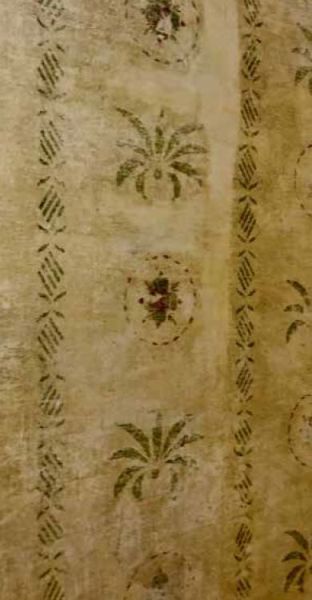New Boston Historical Society
New Boston, New Hampshire

Wall stenciling found in New Boston under wallpaper at 6 Bedford Road in 1975
Early American wall stenciling
by Mary Atai (April 2022)
Some artistic-minded men probably brought ideas with them from Europe. A man could paint flowers and leaves, etc. on a wall, but this was time consuming and laborious. How much quicker and easier it became to create a pattern and reproduce the same image repeatedly. With stencils, an entire room could be painted in hours instead of days.
There is documentation of stenciling in early China and Japan, as well as from fifteenth-century France. In this country, the earliest stenciling began in Massachusetts, but as New Englanders moved west, they took their stenciling ideas with them.
The stencilers were not trained professionals, but rather folk artists from villages. They traveled through New England and worked in return for food, lodging, and a small fee. They decorated walls and even floors to brighten up the drab houses. Their work was more economical than the luxury printed wallpaper just becoming available. They cut their own stencils from heavy brown paper, which had been oiled with animal fat. The designs they cut out were basic and often drawn from nature. Flowers, leaves, running vines, sunbursts, hearts, bells, and pinecones were common. Once the stencils were made, they could be mixed and matched to create many different scenes, thus providing great design flexibility.
They used strong bright colors with little or no shading, and they mixed their own colors most of the time. They used berries, clay, brick dust, soot, iron filings, etc. and mixed these with milk, rum, or water. Eventually pigments could be bought in shops or from peddlers. There is evidence that patterns were usually shown to the homeowner in a little section of an attic or closet, so the desired design could be chosen. Usually several rooms and hallways were done in each house. It was popular to stencil along the top of wainscoting, above mantels and doors, and in vertical lines to divide a room. It was also common to stencil a horizontal frieze of painted decoration at the tops of walls near the ceiling.
The work of various itinerant painters can sometimes be identified by their stencil patterns and style. They almost never signed or dated their work. There are now approximately 15 known stencilers. Others may never be known. Two of the most identifiable were Moses Eaton and New Hampshire’s own Moses Eaton, Jr.
Moses Eaton, Sr. moved to a farm in Hancock in 1792 from Needham, Massachusetts. His son was born in 1796 and learned the art from his father as he grew. Moses stenciled many homes in Dublin, Hancock, and Peterborough. When Moses was 28, he and the muralist Rufus Porter became friends and worked together on a few projects, including the Hancock Inn near the farm. The two learned from each other.
Moses died at age 90 in 1886. His stencil kit was found in the attic of his daughter’s home in Dublin. It contained eight large brushes and 78 stencils used to make 40 complete designs. This kit now belongs to Historic New England.
In the 1840s, wallpaper began to be mass-produced. Much of the stencil work was then covered, in the name of progress. Impressive stenciling has been found under as many as 13 layers of wallpaper. Although stenciling has gone out of style, the story of this art will always be part of the American heritage.
Click here to return to the main page for "Behind the Door" articles.
